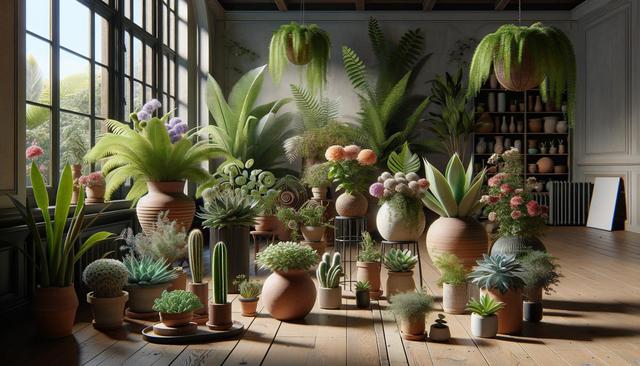Why Houseplants Are More Than Just Decor
Houseplants have become a staple in modern home design, but their value goes far beyond aesthetics. Many people don’t realize that the right indoor greenery can play a meaningful role in supporting emotional well-being and physical health. In fact, bringing nature indoors has been linked to reduced stress, improved air quality, and even better focus and productivity. Choosing the best indoor plants for mental health can turn your living space into a calming retreat, offering more than just visual appeal. Whether you’re working from home, managing daily stress, or simply trying to create a more tranquil space, houseplants offer a subtle yet effective form of support.
Scientific studies have shown that indoor plants can help reduce cortisol levels, which is the hormone most associated with stress. They can also help lower blood pressure and improve feelings of well-being. The presence of greenery can make a room feel more alive and inviting, which naturally has a positive effect on mood. For those looking for top plants for stress relief, a few well-chosen options can make a significant difference in how a space feels and how you feel in it.
Peace Lily: A Calming and Cleansing Companion
The Peace Lily is a popular choice for those seeking houseplants that purify air while also contributing to a serene environment. Known for its elegant white blooms and deep green leaves, this low-light plant is not only beautiful but also practical. It can remove toxins like formaldehyde, benzene, and carbon monoxide from the air, making it one of the most effective plants for improving indoor air quality. The Peace Lily is also considered one of the mood-boosting houseplants due to its soothing appearance and low maintenance needs.
Its health benefits go beyond air purification:
- Helps maintain humidity levels, which can reduce respiratory irritation
- Requires minimal care – water once a week and keep in indirect light
- Improves sleep quality when placed in bedrooms
For anyone new to houseplants, the Peace Lily is an easy low-maintenance indoor plant that offers both emotional and physical health benefits. Its ability to thrive in lower light conditions makes it suitable for a variety of indoor environments, including apartments and offices.
Snake Plant: The Resilient Air Purifier
The Snake Plant, sometimes known as the “mother-in-law’s tongue,” is another excellent option for anyone interested in the health benefits of indoor plants. This hardy plant has tall, upright leaves that are visually striking and incredibly tough, making it ideal for those who might not have a green thumb. One of its biggest advantages is its ability to release oxygen at night, unlike most plants that emit carbon dioxide after dark. This makes it particularly beneficial in bedrooms, where it can contribute to better sleep and clearer breathing.
Here’s why it stands out:
- Filters out harmful toxins like xylene, toluene, and nitrogen oxides
- Thrives on neglect – needs watering only every 2–3 weeks
- Can help reduce symptoms of allergies and asthma
Its reputation as one of the top plants for stress relief is well-earned. The Snake Plant’s upright structure and low-maintenance nature create a sense of order and calm. It’s also one of the best indoor plants for mental health due to its reliable and consistent growth pattern, which offers a sense of stability in any room.
Lavender: Aromatherapy in a Pot
Although typically grown outdoors, Lavender can also thrive indoors with sufficient sunlight. Known for its calming scent, this plant is a natural choice among mood-boosting houseplants. Lavender has been used for centuries in aromatherapy to reduce anxiety, promote sleep, and uplift the mood. Its presence in a room can create a spa-like ambiance, making it a perfect addition to relaxation spaces such as bedrooms or meditation corners.
Lavender’s benefits include:
- Fragrant oils that promote relaxation and better sleep
- Antibacterial properties that help purify the air
- Visual appeal with its purple blooms and soft green leaves
As one of the health benefits of indoor plants, the scent of lavender alone can reduce the need for synthetic air fresheners and help create a healthier home atmosphere. While it does require a bit more sunlight than other houseplants, placing it near a sunny window can ensure it thrives indoors. For those looking for easy low-maintenance indoor plants with big benefits, lavender is a beautiful and functional choice.
Pothos: The Versatile Green Friend
Pothos is often recommended for beginners, and for good reason. This trailing vine is easy to care for, adaptable to various lighting conditions, and excellent for air purification. It is one of the houseplants that purify air effectively, removing pollutants such as formaldehyde, benzene, and xylene. Pothos is also known for being forgiving if you forget to water it occasionally, making it one of the most easy low-maintenance indoor plants available.
Key features of Pothos include:
- Grows in both bright and low-light environments
- Tolerates inconsistent watering
- Can be displayed in hanging baskets or as a climbing plant
This plant’s lush, heart-shaped leaves add a touch of nature to any room, enhancing the atmosphere and offering subtle emotional support. Its presence can help reduce fatigue and stress, making it one of the top plants for stress relief. Whether placed in a living room, kitchen, or office, Pothos delivers visual and health benefits without demanding much in return.
Aloe Vera: Healing and Refreshing
Often associated with skincare, Aloe Vera is more than just a soothing gel source. As a houseplant, it offers several wellness benefits that go beyond its topical uses. It’s one of the mood-boosting houseplants that also contributes to indoor air quality by filtering out formaldehyde and benzene, common in household cleaners and paints. Its fleshy leaves store water, making it drought-tolerant and perfect for busy individuals.
Benefits of Aloe Vera include:
- Air purification and oxygen release at night
- Low maintenance and requires minimal watering
- Can be used for minor burns and skin irritation
Its dual function as both a decorative and medicinal plant makes Aloe Vera a standout among the health benefits of indoor plants. It’s also considered one of the best indoor plants for mental health, as its presence can be a small reminder of self-care and natural healing. For those seeking easy low-maintenance indoor plants with practical uses, Aloe Vera is a smart and therapeutic addition to any home.
Conclusion: Creating a Healthier Home with Houseplants
Integrating houseplants into your living space is a simple yet impactful way to enhance both your environment and your well-being. Whether you’re drawn to the air-purifying powers of Peace Lily and Snake Plant, the calming aroma of Lavender, the forgiving nature of Pothos, or the healing properties of Aloe Vera, each of these top plants for stress relief brings unique benefits. These mood-boosting houseplants not only create a visually appealing atmosphere but also support your mental and physical health in quiet, consistent ways.
For anyone looking to make their home a sanctuary, choosing the best indoor plants for mental health can be a rewarding step. Even if you’re new to indoor gardening, these easy low-maintenance indoor plants offer an accessible entry point to the world of green living. Over time, the subtle presence of nature indoors can help foster mindfulness, reduce anxiety, and improve overall quality of life. Start with one or two and see how your space—and your mood—begins to shift.






